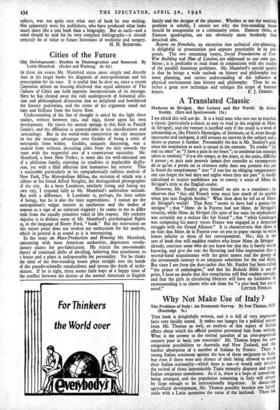Cities of the Future
City Development : Studies in Disintegration and Renewal. By Lewis Mumford. (Seeker and Warburg. 8s. 6d.)
IN these six essays Mr. Mumford states more simply and directly :han in his larger books his diagnosis of metropolitanism and his prescription for its cure. It is useful that he does so, since a recent Commons debate on housing disclosed that equal admirers of The Culture of Cities can hold opposite interpretations of its message. Elere he has cleared away the rich undergrowth of historical allu- sion and philosophical discussion that so delighted and bewildered the literary pedestrian, and the stems of his argument stand out bare and brilliant from the forest floor.
Understanding of his line of thought is aided by the light these studies, written between I92‘. and 5943, throw upon his own development. He traces his mental springs in this field to Patrick Geddes, and the affiliation is unmistakable in his classifications and .erminology. But in the world-wide controversy on city structure he has the strategic advantage over Geddes of being a critic of metropolis from within. Geddes, uniquely discerning, was a student from without, dissecting cities from the skin towards the heart with the respectful awe of a countryman naturalist. Mr. Mumford, a born New Yorker, is more tike the well-educated son of a philistine family, exposing its crudities in implacable disillu- sion, yet with a filial affection that humanises his science. This is noticeable particularly in his sympathetically ruthless analysis of New York, The Metropolitan Milieu, the occasion of which was a sibute to his friend Alfred Stieglitz, the distinguished photographer of the city. As a born Londoner, similarly loving and hating my own city, I respond fully to Mr. Mumford's ambivalent attitude. But with a difference. A Londoner is, perhaps, the least subtle 1 beings, but he is also the least superstitious. I cannot see the metropolitan's vulgar interest in. racehorses and the bodies of women as a sign of an enforced virginity ; he seems to me to differ little from the equally primitive yokel in this respect. My cockney impulse is to dismiss some of Mr. Mumford's psychological flights as, in the language of Henry Ford, " bunk." But my reservation on this minor point does not weaken my enthusiasm for his analysis, which in general is as sound as it is entertaining. In the essay on Mass-Production and Housing Mr. Mumford, concurring with most American authorities, .deprecates revolu- tionary claims for pre-fabrication. He rejects the neo-nomadic theory of continual shifts of dwelling, believing that attachment to. a house and a place is indispensable for personality. Yet he thinks the ideal of the free-standing house plays straight into the hands of the pseudo-scientific standardisers and means the death of archi- tecture. If he is right, there seems little hope of a happy issue of the conflict between the desires of the normal American or English family and the designs of the planner. Whether or not the aesthetic problem is soluble, I cannot see why the free-standing house should be antagonistic to a community sense. Siamese twins, or Siamese quadruplets, are not obviously more brotherly than detached sibs.
Report on Honolulu, an excursion into technical city-planning, is delightful in presentation and appears practicable in its pro- posals. The two remaining essays, Social Foundations of Post- War Building and Plan of London, are addressed to our own pro- blems ; it is profitable to read them in conjunction with the studies of the parallel American problems. Mr. Mumford's special quality is that he brings a wide outlook on history and philosophy into town planning, and carries understanding of the influence of physical environment into history and philosophy. Thus he en-. riches a great new technique and enlarges the scope of humane


























 Previous page
Previous page